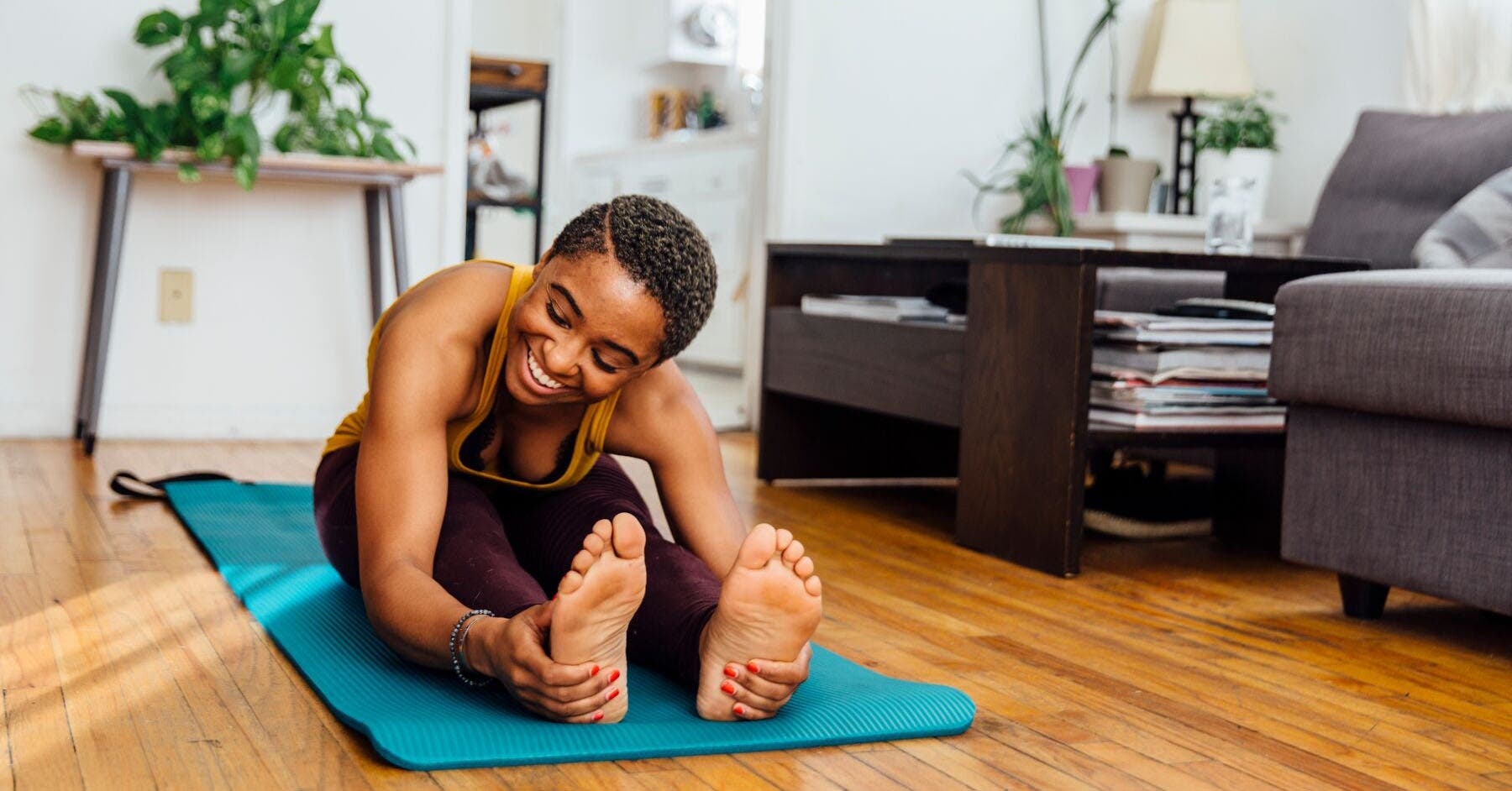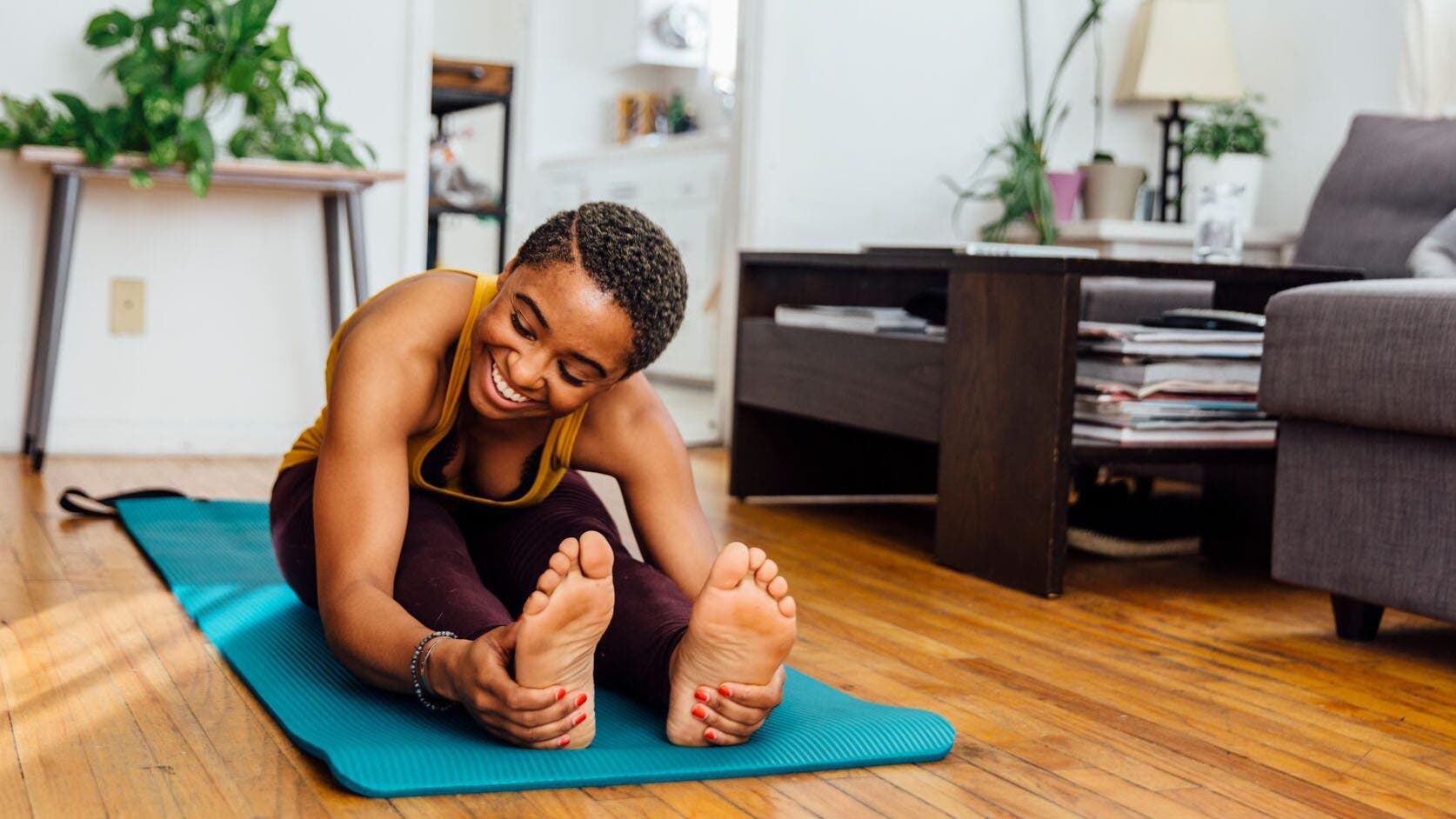10 Stretching Exercises to Improve Flexibility


10 stretching exercises to improve flexibility
Most people know what stretching is, but they don’t do it—and that’s a mistake. “Stretching is an important component of a healthy lifestyle and fitness routine,” says Tom Jones, a certified personal trainer and ultra-endurance athlete. “It increases mobility, promotes circulation, and helps muscles get back to their normal length.” Those benefits help explain why stretching is proven to improve athletic performance—but flexibility isn’t just important for athletes.
Being inactive or spending long periods in one position (like you do when seated at a computer) causes the tissues that connect your muscles to tighten. Over time this affects how much muscles can move and your joints’ range of motion, resulting in postural changes and pain. But stretching can counteract this, helping reduce stiffness, improve your posture, and decrease stress on your joints.
And while there’s little scientific proof, many pros tout an additional perk of flexibility exercises: the feel-good factor. “Stretching can help relieve stress, induce relaxation, and improve your mood,” says Brittany Bendall, a certified Pilates and barre instructor and the creator of the Bump at the Barre and HIIT the Barre programs.
Ready to start stretching? Read on to learn how to add flexibility exercises to your routine, and discover the best stretches for your entire body.
The importance of a stretching routine
“Ideally, you should stretch before and after a workout, but do different types of stretches during each of those times,” says Samantha Parker, a certified personal trainer and yoga therapist.
“Before an activity, do dynamic stretching, which is a term for movements that warm up your muscles and gradually take them to the limits of their range of motion,” Parker recommends. Some examples: neck circles, arm circles, butt kicks, and toe touches. After activity, it’s best to perform the stretching most people commonly think of (and what we’ll focus on): static. Static stretches involve moving to a point where a muscle lengthens, and then holding the position for a set amount of time.
To make stretching a habit, do it after a regularly scheduled activity—such as your daily run, your usual strength workout, or even your morning dog stroll. It only takes a few minutes of flexibility exercises for your body to reap the benefits!
10 best flexibility exercises
Here you’ll find 10 of the best stretches for your upper and lower body. Do a handful every day to create a daily stretching routine. Short on time? “Focus on the body parts you worked during your workout—for example, if you walked, stretch your hips and thighs—or only target the areas where you feel constant tightness,” Bendall says.
1. Kneeling hip-flexor stretch
Whenever you’re seated, the muscles that flex your hips are working overtime. Eventually this can cause tightness and pain, and even affect your posture. This lunging move stretches the hip flexors.
How to do it:
- Kneel with your knees bent 90 degrees, left knee on the floor and right foot a stride’s length in front of it. Right thigh should be parallel to the floor and right knee should be aligned over your ankle.
- Place your right hand on your right hip and raise your left arm overhead.
- Slowly rotate your torso to the left until you feel tension in the front of your left hip. Hold for 30 seconds, then repeat on the opposite side.
2. Wall chest stretch
A hunched over posture causes your chest muscles to tighten—and over time, shorten—making it harder to keep your shoulders pulled back. Help reverse the slump by regularly doing this move.
How to do it:
- Stand in a doorway (the door should be open) with feet staggered, right in front of left.
- Place a hand on each side of the doorframe with your elbows bent, so arms are in a goalpost position.
- Press your shoulders down as you slowly lean your torso forward until you feel a stretch in your chest and the front of your shoulders. Hold for 30 seconds.
3. Butterfly stretch
Open your hips and boost your inner-thigh flexibility with this seated move. If you feel discomfort in your knees, try placing your feet farther away from your body.
How to do it:
- Sit on the floor with knees bent out to sides and feet on the floor just a few inches in front of your torso, soles pressed together.
- Grasp your feet with your hands and sit up tall, aligning your shoulders over your hips.
- Slowly bend forward from your hips until you feel a stretch in your inner thighs and outer hips. Hold for 30 seconds.
To increase the challenge: Bring your feet closer to your torso and use your elbows to press your knees toward the floor.
4. Figure 4 stretch
Walkers and runners, take note: This soothing move eases tension in your overworked hips, thighs, and lower back.
How to do it:
- Lie faceup on the floor with knees bent. Cross your right ankle over your left thigh, just above the knee.
- Grasp the back of your left thigh with both hands.
- Pull left leg toward your chest until you feel a stretch in your right thigh and hip. Hold for 30 seconds. Repeat on the opposite side.
5. Knees to chest
Stretch all the muscles of your lower back with this easy move. Sometimes it’s all it takes to relieve occasional back pain!
How to do it:
- Lie faceup on the floor with your knees bent and your feet flat on the floor.
- Raise your feet and place your hands on your shins, just below your knees.
- Pull your knees toward your chest until you feel a stretch in your lower back. Hold for 30 seconds.
6. Triceps stretch
This exercise targets the muscles that run along the back of your upper arm. You can do it standing, as suggested here, or even seated at your desk.
How to do it:
- Stand with feet hip-width apart and extend your arms overhead.
- Bend left elbow, placing left palm (or fingertips) on upper back. Place right hand on left upper arm, just above your elbow.
- Gently push left arm with right hand until you feel a stretch along the top of your upper left arm. Hold for 30 seconds. Repeat on the opposite side.
7. Standing hamstring stretch
The hamstrings are the muscles that run down the backs of your thighs. When they’re tight, it limits your legs’ range of motion and can even contribute to low back pain. This do-anywhere move stretches the hamstrings, and can easily be modified for different flexibility levels.
How to do it:
- Stand with your feet a stride’s length apart, right foot in front of left, and place hands on hips.
- Bend left knee and shift your weight back onto left foot as you lift right toes so that right foot is flexed, toes pointed toward the ceiling.
- Keep your weight shifted back as you slowly hinge forward from your hips until you feel a stretch in the back of your right thigh. Hold for 30 seconds. Repeat on the opposite side.
To increase the challenge: Place the foot of your extended (stretching) leg on a step or sturdy chair.
8. Piriformis stretch
This move targets the piriformis, a small muscle that’s located behind the gluteus maximus that helps rotate the hip.
How to do it:
- Lie faceup on the floor with legs extended on the floor in front of you and arms extended at your sides.
- Bend your right knee and place your left hand on the outside of your right thigh.
- Keep your shoulders and hips pressed against the floor as you slowly pull your right thigh to the left. Pause when you feel a stretch in the outside of your right hip and glute, and hold for 30 seconds. Repeat on the opposite side.
9. Side bend stretch
This move may be the closest you can get to a full-body stretch. As you reach, you’ll target your shoulders, chest, back, and legs.
How to do it:
- Kneel with your hips aligned over your knees. Extend your right leg out the side and extend both your arms overhead.
- Bend from your hip over to the right as you lower your right hand toward your right foot and reach your left hand to the right.
- Pause when you feel a stretch in the side of your torso and your right leg. Hold for 30 seconds. Repeat on the opposite side.
10. Scalene stretch
This simple move is one of the best stretches for targeting the sides of your neck. Stand up and perform it any time during the day to quickly release tension above your shoulders.
How to do it:
- Stand with your feet hip-width apart, head and shoulders aligned over hips and arms extended at your sides.
- Raise your right arm about 45 degrees from your body and bring it just behind your hips; turn your right palm so it’s facing away from you. Tuck your chin slightly toward your chest and squeeze your right shoulder blade down.
- Slower lower your right ear toward your right shoulder until you feel a stretch in the left side of your neck. Hold for 30 seconds. Repeat on the opposite side.
Stretching exercise tips
Flexibility exercises aren’t complicated, but they can be painful or less effective if done incorrectly. Here are 3 tips for successful stretching:
- Stretch until you feel it: “On a scale of 1 to 10, with 1 meaning you are completely comfortable and 10 meaning you are in pain, you should stretch at about a 7,” Bendall says. “Anything above a 7 could mean you are overstretching and possibly injuring a muscle; and if you’re working below a 7, you’re probably not doing enough to get the benefit from the stretch.”
- Hold the stretch: Once you feel tension, stay still for 30 seconds. While you can hold a stretch longer, the extra time won’t give you any additional flexibility benefits according to research published in the journal Physical Therapy.
- Breathe deeply: “Take deep breaths, and on every exhale focus on relaxing the muscles you’re stretching and the surrounding body parts,” Parker says.
The upshot: Can stretching exercises help your entire body?
Flexibility is a key component of fitness, and it’s beneficial for everyone. “Stretching increases your range of motion, and helps relieve tension, pain, and stress,” Bendall says. That means with every reach, you’re helping your entire body move and feel better. So carve out a few minutes, at least several times a week, to make flexibility exercises a part of your routine.
--
Jeanine Detz is a writer and editor in Los Angeles. She has contributed to many publications, including: Consumer Reports on Health, Cosmopolitan, Family Circle, Men’s Health, Parents, and Women’s Health.
